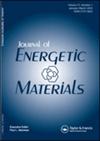Solubility determination and prediction for FOX-7 in three binary solvents at different temperatures
IF 1.9
3区 材料科学
Q3 CHEMISTRY, APPLIED
引用次数: 1
Abstract
ABSTRACT The solid–liquid equilibrium and thermodynamic properties of FOX-7 in three binary mixed solvents (N-methyl pyrrolidone-water, N,N-dimethylacetamide-water and 1,4-Butyrolactone-water) are studied by focused beam reflectance measurement (FBRM) dynamic detection method and the solubility is predicted by conductor-like screening model for real solvents (COSMO-RS) under atmospheric pressure from 298.15 to 343.15 K. The results show that the solubility of FOX-7 increase with the increasing temperature and the mole fraction of N-methyl pyrrolidone, N,N-dimethylacetamide and 1,4-Butyrolactone. The solubility data can be well correlated by Apelblat, van’t Hoff and Yaws equation. The data of hybrid thermodynamic parameters (including the hybrid enthalpy, entropy, and Gibbs energy) show that the dissolution process is endothermic, non-spontaneous and enthalpy driven. In addition, COSMO-RS can accurately predict the increasing trend of solubility with increasing of temperature and mole fraction of solvent. However, the COSMO-RS overestimates solubility in three binary solvents except for x NMP = 0.1575, the average mean squared quadratic error becomes larger with an increasing mole fraction of water. Solubility data and thermodynamic parameters can lay a foundation for the crystallization and spheroidization modification of FOX-7.FOX-7在三种二元溶剂中不同温度下溶解度的测定与预测
本文章由计算机程序翻译,如有差异,请以英文原文为准。
求助全文
约1分钟内获得全文
求助全文
来源期刊

Journal of Energetic Materials
工程技术-材料科学:综合
CiteScore
5.70
自引率
4.80%
发文量
34
审稿时长
1.8 months
期刊介绍:
The Journal of Energetic Materials fills the need for an international forum of scientific and technical interchange in the disciplines of explosives, propellants, and pyrotechnics. It is a refereed publication which is published quarterly. Molecular orbital calculations, synthetic and analytical chemistry, formulation, ignition and detonation properties, thermal decomposition, hazards testing, biotechnology, and toxicological and environmental aspects of energetic materials production are appropriate subjects for articles submitted to the Journal.
 求助内容:
求助内容: 应助结果提醒方式:
应助结果提醒方式:


